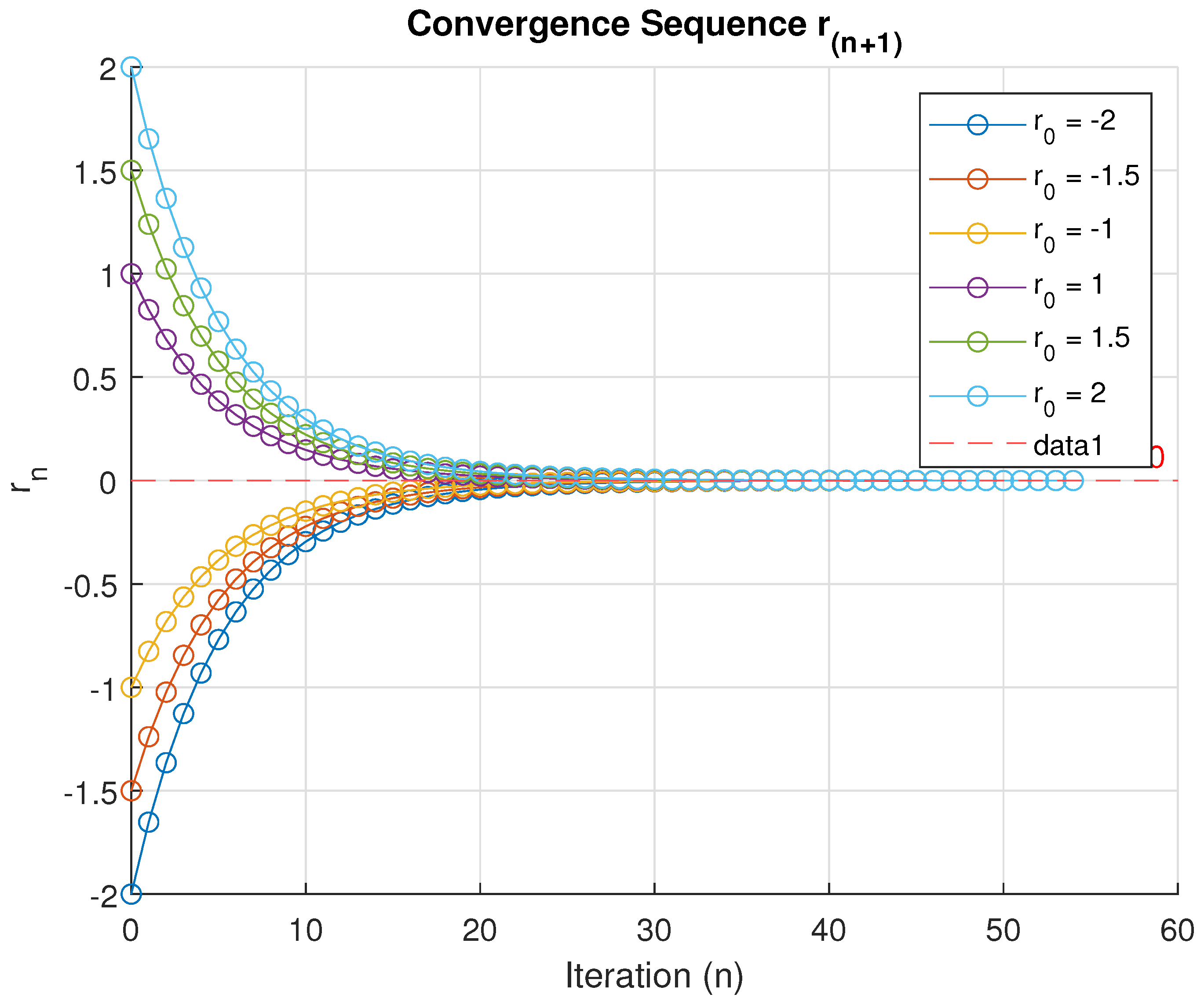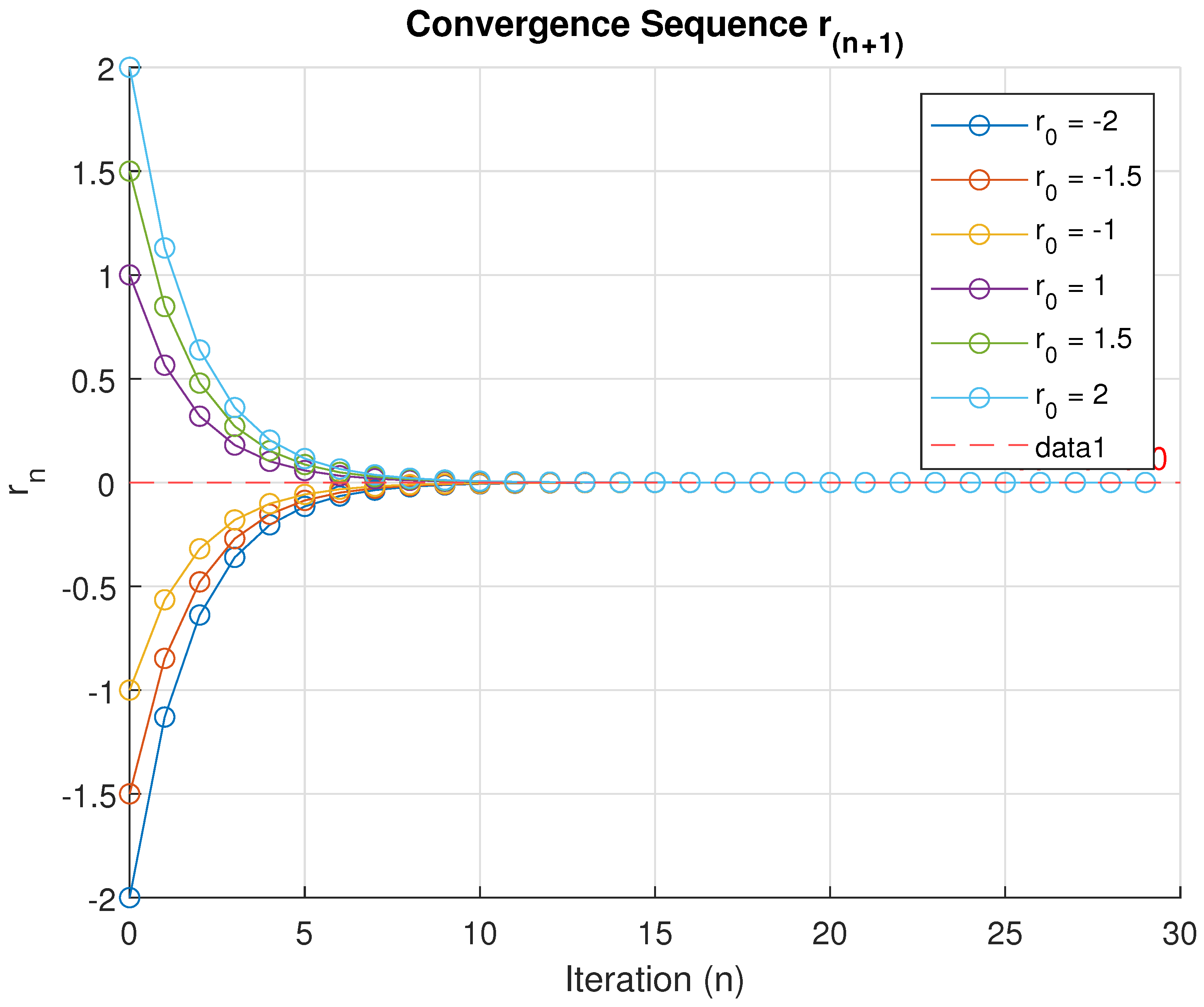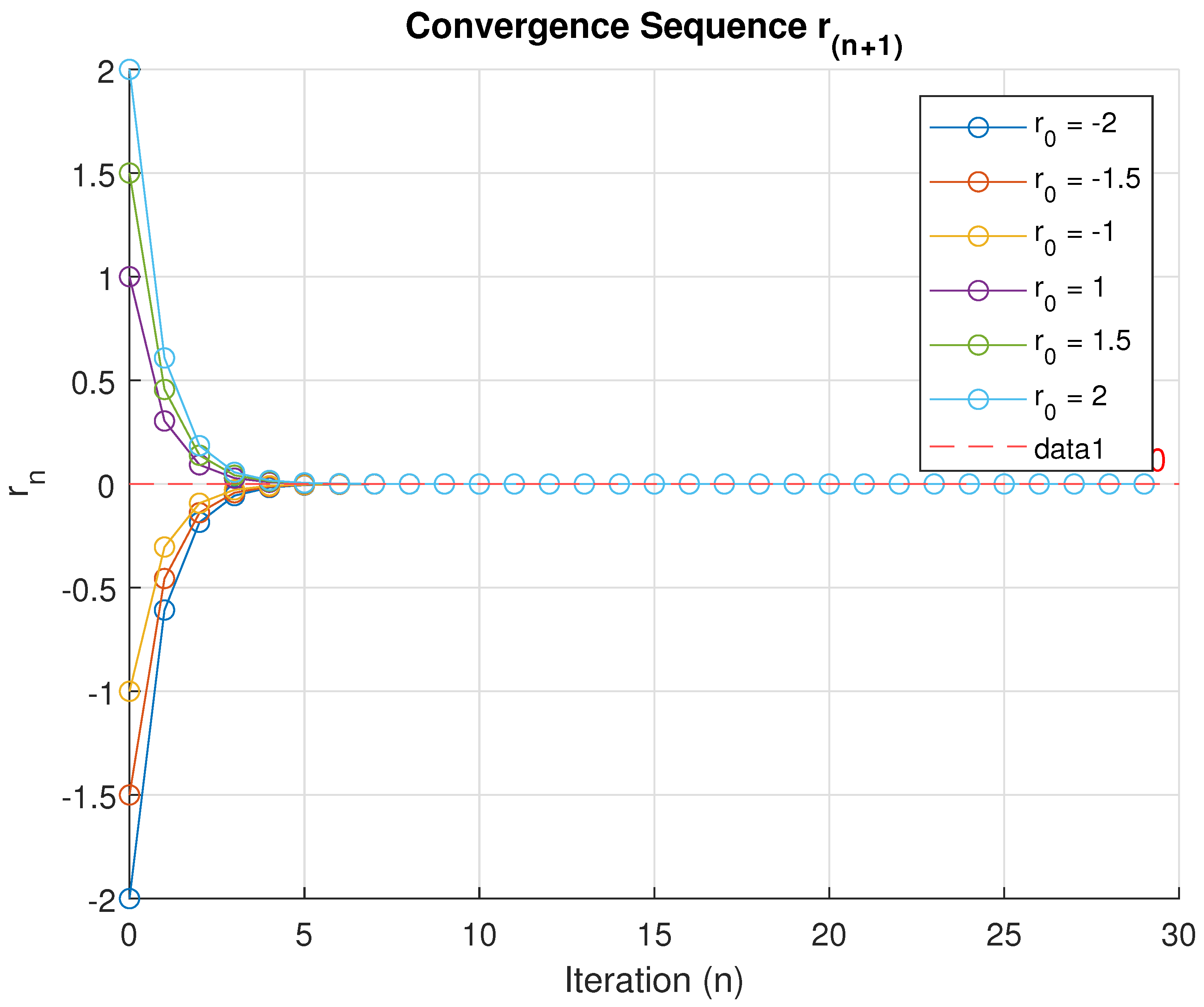Convergence Analysis for Cayley Variational Inclusion Problem Involving XOR and XNOR Operations
Abstract
1. Introduction
2. Elementary Tools
- (i)
- = ;
- (ii)
- ;
- (iii)
- ;
- (iv)
- = .
- (i)
- ;
- (ii)
- if then ;
- (iii)
- ;
- (iv)
- if ;
- (v)
- if then if and only if
- (i)
- ;
- (ii)
- ;
- (iii)
- ;
- (iv)
- if then
- (i)
- Υ is called Lipschitz continuous in the first argument if there exists a constant and for any such that
- (ii)
- Υ is called Lipschitz continuous in the second argument if there exists a constant and for any such that
- (iii)
- Υ is called Lipschitz continuous in the third argument if there exists a constant and for any such that
- (i)
- is called strong comparison mapping if is comparison mapping and if and only if
- (ii)
- is called ρ-order non-extended mapping if there exists a constant such that
- (iii)
- is called a comparison mapping if and such that
- (iv)
- D is called a comparison mapping if any and if as well as for any and such that
- (v)
- The comparison mapping D is called an non-ordinary difference mapping if and such that
- (vi)
- The comparison mapping D is called ρ-ordered rectangular mapping. If there exists a constant then there exists and such that
- (vii)
- D is called a weak comparison mapping if any or and there exists and such that
- (viii)
- D is called weak-ordered different mapping if there exists a constant and there exists and such that
- (ix)
- A weak comparison mapping D is called weak ANODD if it is an weak non-ordinary difference mapping and ρ-order different weak-comparison mapping with respect to and
3. Statement of the Cayley Inclusion Problem
4. Fixed-Point Formulation and Iterative Algorithm
5. Main Result
| Algorithm 1 For every and , enumerate the sequence and by taking after the iterative algorithm. |
6. Numerical Result
- (i)
- Again, let us consider to be the single-valued mappings, to be another single-valued mapping, and to be another multi-valued mapping such thatThen, for any , we haveThus, g is Lipschitz continuous with constant andSimilarly, g is strongly monotone with constant =
- (ii)
- Suppose is the single-valued mapping and is the multi-valued mappings such thatNow, we haveSo, ψ is -Lipschitz continuous with constant Similarly, we have to show that andHence, Υ is Lipschitz continuous in three arguments with constant Thus, we obtain
- (iii)
- Suppose is the single-valued mappings; is a multi-valued mapping such thatNow, we haveThus, is Lipschitz continuous with constant . Similarly, we have to show that is Lipschitz continuous with constant . In addition, and are ξ-ordered non-extended mappings with constant
- (iv)
- Suppose is the multi-valued mappings and for every constant such thatNow, letting , it is clear that D is -weak ANODD mapping with .
- (v)
- Now, we calculate the obtained resolvent operators such thatAlso, we haveThus, is Lipschitz continuous with constant , where
- (vi)
- Using the values of , we obtain the generalized Cayley approximation operator asNow, we haveThus, is Lipschitz continuous with constant where
- (vii)
- Now, we consider the interval and .
- (viii)
- Considering the constants calculated above, condition (7) of Theorem 1 is satisfied.
- (ix)
- Now putting all values in Equation (3), we obtainIn this numerical result, we consider three cases for the composition of the computation table and convergence graph we use the tools of MATLAB-R2024b with some different initial values of and the value of constant α, where .In the first case, Consider , and various initial values We obtain an excellent graph of the convergence sequence which converges at (after fifty-one iterations), which is the solution of the Cayley variational inclusion problem (1). It is shown through a computation table (Table 1) and convergence graph (Figure 1).
7. Conclusions
Author Contributions
Funding
Institutional Review Board Statement
Data Availability Statement
Conflicts of Interest
References
- Hassouni, A.; Moudafi, A. A perturbed algorithm for variational inclusions. J. Math. Anal. Appl. 1994, 185, 706–712. [Google Scholar] [CrossRef]
- Noor, M.A. Generalized set-valued variational inclusions and resolvent equations. J. Math. Anal. Appl. 1998, 228, 206–220. [Google Scholar] [CrossRef]
- Ahmad, I.; Irfan, S.S.; Farid, M.; Shukla, P. Nonlinear ordered variational inclusion problem involving XOR operation with fuzzy mappings. J. Inequal. Appl. 2020, 2020, 36. [Google Scholar] [CrossRef]
- Ahmad, I.; Pang, C.T.; Ahmad, R.; Ishtyak, M. System of Yosida inclusions involving XOR-operation. J. Nonlinear Convex Anal. 2017, 18, 831–845. [Google Scholar]
- Ayaka, M.; Tomomi, Y. Applications of the Hille—Yosida theorem to the linearized equations of coupled sound and heat flow. AIMS Math. 2016, 1, 165–177. [Google Scholar] [CrossRef]
- Chang, S.S. Set-valued variational inclusions in Banach spaces. J. Math. Anal. Appl. 2000, 248, 438–454. [Google Scholar] [CrossRef]
- Chang, S.; Yao, J.C.; Wang, L.; Liu, M.; Zhao, L. On the inertial forward-backward splitting technique for solving a system of inclusion problems in Hilbert spaces. Optimization 2021, 70, 2511–2525. [Google Scholar] [CrossRef]
- Yosida, K. Functional Analysis, Grundlehren der Mathematischen Wissenschaften; Springer: New York, NY, USA, 1971. [Google Scholar]
- Iqbal, J.; Rajpoot, A.K.; Islam, M.; Ahmad, R.; Wang, Y. System of Generalized Variational Inclusions Involving Cayley Operators and XOR-Operation in q-Uniformly Smooth Banach Spaces. Mathematics 2022, 10, 2837. [Google Scholar] [CrossRef]
- Khan, A.A.; Tammer, M.; Zalinescu, C. Set-Valued Optimization: An Introduction with Applications; Springer: New York, NY, USA, 2015. [Google Scholar]
- Iqbal, J.; Wang, Y.; Rajpoot, A.K.; Ahmad, R. Generalized Yosida inclusion problem involving multi-valued operator with XOR operation. Demonstr. Math. 2024, 57, 20240011. [Google Scholar] [CrossRef]
- Ali, I.; Ahmad, R.; Wen, C.F. Cayley Inclusion Problem Involving XOR-Operation. Mathematics 2019, 7, 302. [Google Scholar] [CrossRef]
- Rockafellar, R. Monotone Operators and the Proximal Point Algorithm. Siam J. Cont. Optim. 1976, 14, 877–898. [Google Scholar] [CrossRef]



| No. of Iterations | ||||||
|---|---|---|---|---|---|---|
| n = 1 | −1.65200 | −1.23900 | −0.82600 | 0.82600 | 1.23900 | 1.65200 |
| n = 2 | −1.36460 | −1.02340 | −0.68220 | 0.68220 | 1.02340 | 1.36460 |
| n = 3 | −1.12710 | −0.84534 | −0.56356 | 0.56356 | 0.84534 | 1.12710 |
| n = 4 | −0.93100 | −0.69825 | −0.46550 | 0.46550 | 0.69825 | 0.93100 |
| n = 5 | −0.76901 | −0.57676 | −0.38450 | 0.38450 | 0.57676 | 0.76901 |
| n = 6 | −0.63520 | −0.47640 | −0.31760 | 0.31760 | 0.47640 | 0.63520 |
| n = 15 | −0.11369 | −0.08526 | −0.05684 | 0.05684 | 0.08526 | 0.11369 |
| n = 20 | −0.04371 | −0.03278 | −0.02185 | 0.02185 | 0.03278 | 0.04371 |
| n = 25 | −0.01680 | −0.01260 | −0.00840 | 0.00840 | 0.01260 | 0.01680 |
| n = 35 | −0.00248 | −0.00186 | −0.00124 | 0.00124 | 0.00186 | 0.00248 |
| n = 51 | −0.00011 | −0.00000 | −0.00000 | 0.00000 | 0.00000 | 0.00011 |
| n = 55 | −0.00000 | −0.00000 | −0.00000 | 0.00000 | 0.00000 | 0.00000 |
| No. of Iterations | ||||||
|---|---|---|---|---|---|---|
| n = 1 | −1.13000 | −0.84750 | −0.56500 | 0.56500 | 0.84750 | 1.13000 |
| n = 2 | −0.63845 | −0.47884 | −0.31922 | 0.31922 | 0.47884 | 0.63845 |
| n = 3 | −0.36072 | −0.27054 | −0.18036 | 0.18036 | 0.27054 | 0.36072 |
| n = 4 | −0.20381 | −0.15286 | −0.10190 | 0.10190 | 0.15286 | 0.20381 |
| n = 5 | −0.11515 | −0.08636 | −0.05757 | 0.05757 | 0.08636 | 0.11515 |
| n = 6 | −0.06506 | −0.04879 | −0.03253 | 0.03253 | 0.04879 | 0.06506 |
| n = 7 | −0.03675 | −0.02757 | −0.01838 | 0.01838 | 0.02757 | 0.03675 |
| n = 11 | −0.00663 | −0.00497 | −0.00331 | 0.00331 | 0.00497 | 0.00663 |
| n = 14 | −0.00119 | −0.00089 | −0.00059 | 0.00059 | 0.00089 | 0.00119 |
| n = 17 | −0.00021 | −0.00016 | −0.00010 | 0.00010 | 0.00016 | 0.00021 |
| n = 18 | −0.00012 | −0.00000 | −0.00000 | 0.00000 | 0.00000 | 0.00012 |
| n = 19 | −0.00000 | −0.00000 | −0.00000 | 0.00000 | 0.00000 | 0.00000 |
| n = 30 | −0.00000 | −0.00000 | −0.00000 | 0.00000 | 0.00000 | 0.00000 |
| No. of Iterations | ||||||
|---|---|---|---|---|---|---|
| n = 1 | −0.60800 | −0.45600 | −0.30400 | 0.30400 | 0.45600 | 0.60800 |
| n = 2 | −0.18483 | −0.13862 | −0.09241 | 0.09241 | 0.13862 | 0.18483 |
| n = 3 | −0.05618 | −0.04214 | −0.02809 | 0.02809 | 0.04214 | 0.05618 |
| n = 4 | −0.01708 | −0.01281 | −0.00854 | 0.00854 | 0.01281 | 0.01708 |
| n = 5 | −0.00519 | −0.00389 | −0.00259 | 0.00259 | 0.00389 | 0.00519 |
| n = 6 | −0.00157 | −0.00118 | −0.00078 | 0.00078 | 0.00118 | 0.00157 |
| n = 7 | −0.00047 | −0.00035 | −0.00023 | 0.00023 | 0.00035 | 0.00047 |
| n = 8 | −0.00014 | −0.00010 | −0.00000 | 0.00000 | 0.00010 | 0.00014 |
| n = 9 | −0.00000 | −0.00000 | −0.00000 | 0.00000 | 0.00000 | 0.00000 |
| n = 10 | −0.00000 | −0.00000 | −0.00000 | 0.00000 | 0.00000 | 0.00000 |
| n = 15 | −0.00000 | −0.00000 | −0.00000 | 0.00000 | 0.00000 | 0.00000 |
| n = 20 | −0.00000 | −0.00000 | −0.00000 | 0.00000 | 0.00000 | 0.00000 |
| n = 30 | −0.00000 | −0.00000 | −0.00000 | 0.00000 | 0.00000 | 0.00000 |
Disclaimer/Publisher’s Note: The statements, opinions and data contained in all publications are solely those of the individual author(s) and contributor(s) and not of MDPI and/or the editor(s). MDPI and/or the editor(s) disclaim responsibility for any injury to people or property resulting from any ideas, methods, instructions or products referred to in the content. |
© 2025 by the authors. Licensee MDPI, Basel, Switzerland. This article is an open access article distributed under the terms and conditions of the Creative Commons Attribution (CC BY) license (https://creativecommons.org/licenses/by/4.0/).
Share and Cite
Arifuzzaman; Irfan, S.S.; Ahmad, I. Convergence Analysis for Cayley Variational Inclusion Problem Involving XOR and XNOR Operations. Axioms 2025, 14, 149. https://doi.org/10.3390/axioms14030149
Arifuzzaman, Irfan SS, Ahmad I. Convergence Analysis for Cayley Variational Inclusion Problem Involving XOR and XNOR Operations. Axioms. 2025; 14(3):149. https://doi.org/10.3390/axioms14030149
Chicago/Turabian StyleArifuzzaman, Syed Shakaib Irfan, and Iqbal Ahmad. 2025. "Convergence Analysis for Cayley Variational Inclusion Problem Involving XOR and XNOR Operations" Axioms 14, no. 3: 149. https://doi.org/10.3390/axioms14030149
APA StyleArifuzzaman, Irfan, S. S., & Ahmad, I. (2025). Convergence Analysis for Cayley Variational Inclusion Problem Involving XOR and XNOR Operations. Axioms, 14(3), 149. https://doi.org/10.3390/axioms14030149








